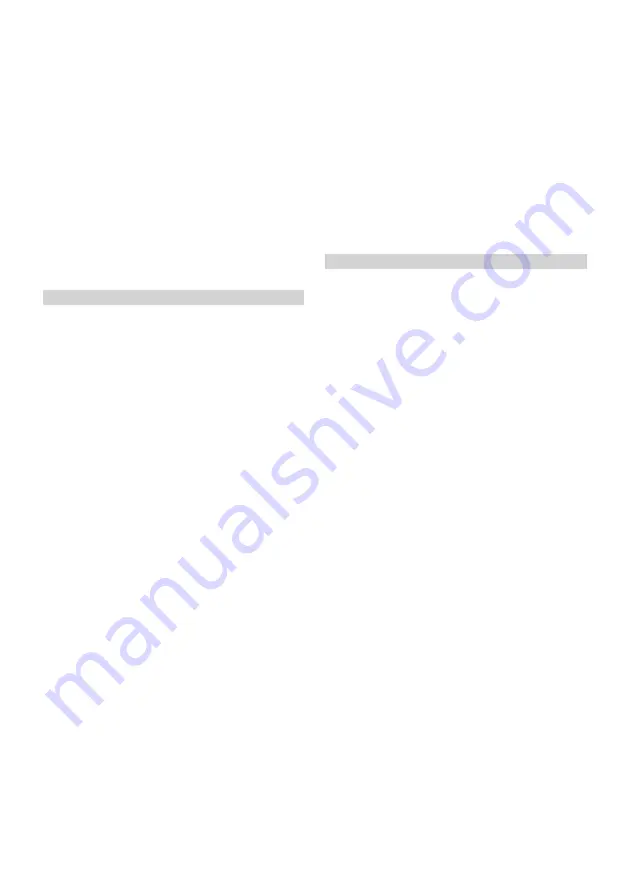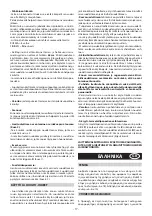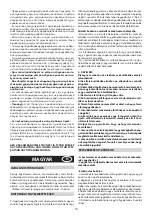
- 10 -
A) Do not check the status of the filters while the cooker
hood is operating.
B) Do not touch bulbs or adjacent areas, during or straight
after prolonged use of the lighting installation.
C) Flambè cooking is prohibited underneath the cooker
hood.
D) Avoid free flame, as it is damaging for the filters and a
fire hazard.
E) Constantly check food frying to avoid that the over
-
heated oil may become a fire hazard.
F) Disconnect the electrical plug prior to any maintenance.
G) This appliance is not intended for use by young children
or infirm persons without supervision.
H) Young children should be supervised to ensure they
do not play with the appliance.
I) There shall be adequate ventilation of the room when
the rangehood is used at the same time as appliances
burning gas or other fuels.
L) There is a risk of fire if cleaning is not carried out in
accordance with the instructions.
INSTALLATION INSTRUCTIONS
• Assembly and electrical connections must be carried out
by specialised personnel.
• Wear protective gloves before proceeding with the
installation.
• Electric Connection:
- The appliance has been manufactured as a class II, therefore
no earth cable is necessary. The plug must be easily acces-
sible after the installation of the appliance. If the appliance
is equipped with power cord without plug, a suitably di-
mensioned omnipolar switch with 3 mm minimum opening
between contacts must be fitted between the appliance and
the electricity supply in compliance with the load and current
regulations.
- The connection to the mains is carried out as follows:
BROWN =
L
line
BLUE =
N
neutral.
•
If the hob is electric, gas, or induction, the minimum distance
between the same and the lower part of the hood must be
at least
65 cm
. If a connection tube composed of two parts is
used, the upper part must be placed outside the lower part. Do
not connect the cooker hood exhaust to the same conductor
used to circulate hot air or for evacuating fumes from other
appliances generated by other than an electrical source.
- In the case of assembly of the appliance in the suction version
prepare the hole for evacuation of the air.
•
We recommend the use of an air exhaust tube which has the
same diameter as the air exhaust outlet hole. If a pipe with
a smaller diameter is used, the efficiency of the product may
be reduced and its operation may become noisier.
• Warning:
if the bulbs are not working, ensure that they are
screwed in fully.
• Installation:
Prior to proceeding with the assembly operations (according
to the model that you have purchased), to facilitate handling
of the device, remove the grille as indicated in figure 4-5.
• Fixing the hood to the lower part of the wall cabinet
(Fig.2):
- Make 4 holes in the wall cabinet respecting the measure-
ments indicated in figures 2.
- Position the hood underneath the wall cabinet and fix it
into place using 4 screws
B
(supplied) suitable for the type of
cabinet.
• Extractor version:
The appliance expels the fumes through an outside wall or
a duct. It is necessary to buy a telescopic pipe in accordance
with the standards in use (inflammable) and connect it to
flange
D
(Fig.1).
• Filtering version:
To transform an extractor hood version into a filter hood ver-
sion, contact your appliance dealer and ask for active charcoal
filters. The filters should be fitted to the extraction assembly
inside the hood, by centring them and rotating them 90
degrees, until they click into place (Fig.6-7).
USE AND MAINTENANCE
•
We recommend that the cooker hood is switched on before
any food is cooked. We also recommend that the appliance is
left running for 15 minutes after the food is cooked, in order
to thoroughly eliminate all contaminated air. The effective
performance of the cooker hood depends on constant main-
tenance; the anti-grease filter and the active carbon filter both
require special attention.
• The anti-grease filter
is responsible retaining the grease
particles suspended in the air, therefore it is subject to clog-
ging with variable frequency according to the use of the
appliance.
- To prevent the danger of possible fires, at least every 2
months one must wash the anti-grease filters by hand using
non-abrasive neutral liquid detergents or in the dishwasher
at low temperatures and on short cycles.
- In the event that acrylic anti-grease filters are used, hand-
wash every 2 months, using neutral non-abrasive liquid
detergents and replace them after every 6 washes.
- After a few washes, colour alterations may occur. This does
not give the right to claim their replacement.
• The active carbon filters
are used to purify the air that is
sent back into the room and its function is to mitigate the
unpleasant odours produced by cooking.
- The non-regenerable active carbon filters must be replaced
at least every 4 months. The saturation of the active charcoal
depends on the more or less prolonged use of the appliance,
on the type of kitchen and on the frequency with which anti-
grease filter is cleaned.
• Before remounting the anti-grease filters and the regen
-
erable active charcoal filters it is important that they are
completely dry.
• Clean the hood frequently, both internally and exter
-
nally, using a cloth dampened with denatured alcohol or
neutral liquid detergents that are non abrasive.
•
The lighting .system is designed for use during cooking
and not for the prolonged general lighting of the room. The
prolonged use of the lighting system significantly decreases
the average duration of the bulbs.
• Attention:
the non compliance with the hood cleaning
warnings and with the replacement and cleaning of the filters
entails risk of fires. One therefore recommends keeping to the
suggested instructions.
• Replacing the acrylic or metal panels:
To replace the acrylic or metal panels, first remove grille
D
by
pressing the two side buttons
B
, as shown in Fig.4. Remove
the two filter clips
B
(Fig.8) and the acrylic or metal panel
C
.











































